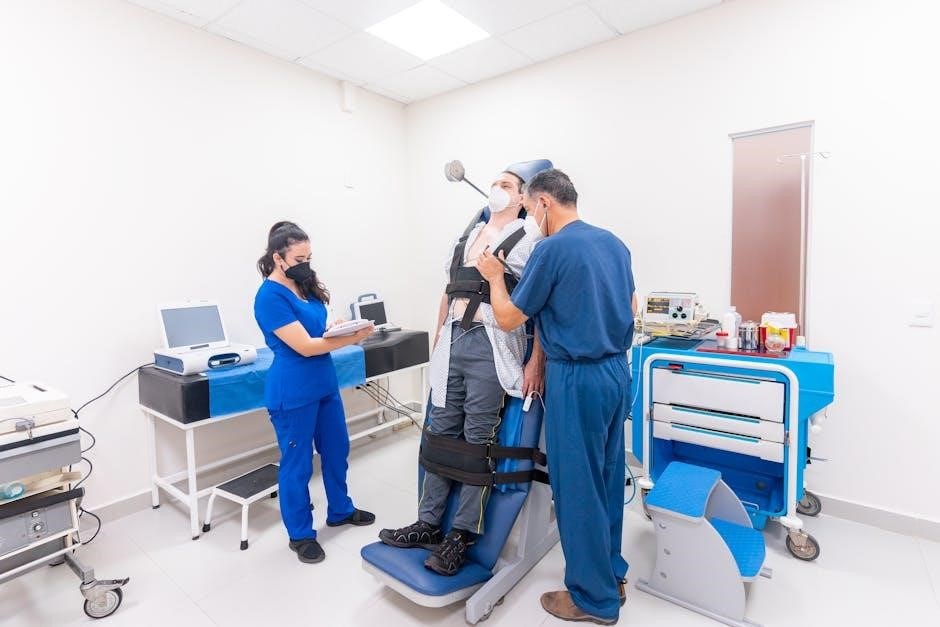New patient forms are essential for collecting personal and medical history details, ensuring comprehensive records and informed care. They streamline intake processes and require patient consent for treatment.
1.1 Overview of New Patient Forms
New patient forms are documents used to gather essential information about individuals seeking medical care for the first time. These forms typically include sections for personal details, medical history, and emergency contacts. They are designed to streamline the intake process, ensuring healthcare providers have all necessary data to deliver appropriate care. Available in PDF formats, these forms are easily downloadable, fillable, and printable, making them convenient for both patients and providers. They often include fillable fields and digital signature options, enhancing efficiency and compliance with privacy standards. By standardizing patient information collection, these forms help maintain accurate and comprehensive medical records.
1.2 Purpose and Function

The primary purpose of new patient forms is to collect detailed information necessary for providing effective healthcare. They function as a critical tool for healthcare providers to assess patient needs, identify health risks, and design personalized treatment plans. By capturing medical history, allergies, and current conditions, these forms help avoid diagnostic delays and ensure continuity of care. Additionally, they serve as legal documents, obtaining patient consent for accessing and sharing medical records. The function extends to streamlining administrative tasks, reducing paperwork, and enhancing the overall efficiency of the patient intake process. This ensures a smooth and organized experience for both patients and healthcare providers alike, promoting better communication and care outcomes.
Importance of New Patient Forms
New patient forms are essential for streamlining intake processes, ensuring accurate medical records, and enhancing communication between patients and providers. They improve care coordination and compliance with legal standards.
2.1 Streamlining Patient Intake Process
New patient forms optimize the intake process by reducing paperwork and minimizing delays. Digital formats allow patients to fill out forms in advance, ensuring all necessary information is collected efficiently. This reduces wait times and improves the overall patient experience. Additionally, pre-filled forms enable healthcare providers to review patient data before appointments, allowing for better preparation and more focused consultations. Streamlined intake processes also reduce administrative burdens, freeing up staff to focus on patient care. By integrating PDF formats, practices can ensure data accuracy and maintain organized records, enhancing the efficiency of the entire onboarding process.
2.2 Enhancing Patient-Provider Communication
New patient forms play a crucial role in improving communication between patients and healthcare providers. By collecting detailed medical histories, current conditions, and allergies, these forms ensure providers have a clear understanding of patient needs. This reduces misunderstandings and allows for more accurate diagnoses and personalized treatment plans. The structured format of PDF forms ensures information is presented clearly, making it easier for providers to identify key details. Digital signatures also confirm patient consent, fostering trust and transparency. Effective communication is further enhanced as providers can quickly access organized, legible records, enabling them to address patient concerns efficiently and deliver high-quality care.
2.3 Ensuring Comprehensive Medical Records
New patient forms are vital for maintaining accurate and detailed medical records. These forms collect essential information such as medical history, current conditions, allergies, and medications, ensuring a complete patient profile. The structured format of PDF forms helps organize data, reducing errors and improving accessibility. Digital versions allow for easy updates and secure storage, ensuring records remain current and confidential. Comprehensive records enable healthcare providers to track patient progress, identify patterns, and make informed decisions. This centralized information also facilitates seamless communication among healthcare teams, leading to better continuity of care and improved patient outcomes over time. Accurate records are foundational for effective treatment plans and long-term patient management;
Essential Elements of New Patient Forms
New patient forms include essential elements like personal information, medical history, insurance details, and emergency contacts to ensure comprehensive and organized patient data collection.
3.1 Personal Information Section
The personal information section of new patient forms collects essential details such as name, gender, date of birth, contact information, and emergency contacts. This section ensures accurate patient identification and communication. It may also include fields for social security number or government-issued ID to maintain record authenticity. Additionally, some forms request preferred communication methods and relationship status to tailor care and correspondence. This section is crucial for creating a foundation for patient records and ensuring proper communication between healthcare providers and patients. The information gathered here helps streamline administrative processes and supports efficient patient care coordination.
3.2 Medical History Details
The medical history section of new patient forms collects critical information about a patient’s health, including allergies, current medications, and pre-existing conditions. It also asks about past surgeries, chronic illnesses, and family medical history. This section may inquire about lifestyle habits, such as smoking or alcohol use, and previous diagnoses like diabetes or hypertension. Detailed medical history helps healthcare providers understand potential health risks and develop personalized treatment plans. Accurate and comprehensive information in this section is vital for ensuring safe and effective care, as it informs diagnostic decisions and prevents adverse reactions to medications or treatments.
3.3 Insurance and Payment Information
The insurance and payment section of new patient forms collects details about a patient’s health insurance coverage, including the provider name, policy number, and coverage dates. It also requests information about secondary insurance, if applicable. Patients are typically asked to provide their payment method preferences, such as credit card details or insurance co-pay amounts. This section may include a financial agreement outlining the patient’s responsibility for unpaid balances or charges not covered by insurance. Accurate insurance and payment details ensure smooth billing processes and minimize financial misunderstandings between patients and healthcare providers. This information is critical for maintaining transparent and efficient financial transactions.
3;4 Emergency Contact Information
This section requires patients to provide details of at least one emergency contact, including their name, relationship, phone number, and address. It ensures healthcare providers can reach someone in case of a medical emergency. Patients may also list additional contacts for added security. This information is critical for situations where the patient cannot communicate themselves. Accurate and up-to-date emergency contact details help providers act swiftly and responsibly. It also gives patients peace of mind, knowing their loved ones can be reached if needed. This section is a vital part of ensuring patient safety and effective communication in urgent situations.

Types of New Patient Forms
New patient forms include registration, health history, consent, and financial agreements, each serving distinct purposes to ensure smooth patient onboarding and compliant care delivery.
4.1 Patient Registration Forms
Patient registration forms are essential for gathering basic information about new patients. They typically include personal details such as name, date of birth, gender, and contact information. These forms also collect insurance details, emergency contacts, and a brief medical history. The purpose of registration forms is to streamline the intake process and ensure that healthcare providers have all necessary information to deliver appropriate care. They are often the first step in creating a comprehensive medical record and are typically available in PDF formats for easy downloading and editing. By completing these forms, patients provide consent for their information to be used for treatment and record-keeping purposes.

4.2 Health History Questionnaires
Health history questionnaires are detailed forms that gather comprehensive medical information about a patient. They inquire about allergies, past illnesses, surgeries, medications, and lifestyle factors such as smoking or alcohol use. These questionnaires help healthcare providers identify potential health risks and develop appropriate treatment plans. By understanding a patient’s medical background, providers can make informed decisions and avoid complications. The information collected is crucial for maintaining accurate and up-to-date medical records, ensuring continuity of care.
These forms are often included in new patient packets and are available in PDF formats for easy completion. They play a vital role in enhancing patient-provider communication and personalized care.
4.3 Informed Consent Forms
Informed consent forms are legal documents that ensure patients understand and agree to a proposed treatment or procedure. These forms outline the risks, benefits, and alternatives, ensuring patients make informed decisions. They protect both patients and healthcare providers by documenting mutual understanding and consent. Informed consent is a critical step in maintaining ethical standards and transparency in healthcare. These forms are often included in new patient packets and are available in PDF formats for easy access and completion. They play a vital role in upholding patient autonomy and legal compliance in medical practices.
4.4 Financial Agreement Forms
Financial agreement forms outline payment responsibilities, insurance details, and billing policies for patients. They ensure clarity on costs, payment plans, and insurance coverage, reducing future disputes. These forms are crucial for transparent financial arrangements, fostering trust between patients and healthcare providers. By signing, patients acknowledge their financial obligations and agree to the outlined terms. Financial agreement forms are often part of new patient packets and are available in PDF formats for easy access and completion. They help streamline billing processes and ensure compliance with financial policies, making them an essential component of patient onboarding in healthcare settings.

Features of PDF New Patient Forms
Patient forms in PDF format offer fillable fields for easy data entry, digital signature integration for secure authorization, and editable options to customize content according to specific needs.
5.1 Fillable Fields for Easy Data Entry
Fillable fields in PDF new patient forms simplify data entry, allowing patients to input information such as name, date of birth, and medical history directly into the document. These fields are designed to reduce errors and save time, ensuring that healthcare providers receive accurate and complete information. Patients can easily type their details using a computer or mobile device, eliminating the need for handwritten forms. This feature enhances legibility and improves the efficiency of the intake process, making it more convenient for both patients and healthcare providers to manage and access medical records securely.
5.2 Digital Signature Integration
Digital signature integration in PDF new patient forms allows patients to securely sign documents electronically, eliminating the need for physical signatures. This feature enhances security by authenticating the signer’s identity and ensuring the integrity of the form. Patients can easily add their signatures using digital tools, streamlining the process and reducing paperwork. Healthcare providers benefit from faster document completion and improved record-keeping. Digital signatures also ensure compliance with legal and regulatory requirements, maintaining patient privacy and data security. This feature is particularly useful for remote patient intake, making it a convenient and efficient solution for modern healthcare practices while maintaining the highest standards of confidentiality and professionalism.
5.3 Editable and Downloadable Formats
PDF new patient forms are designed to be editable and downloadable, allowing users to input information directly into the document. This feature enables patients to fill out forms conveniently on their devices, saving time and reducing errors. Once completed, the forms can be downloaded for personal records or submitted electronically to healthcare providers. The editable format ensures that patients can easily update their information if needed, while the downloadable option provides a secure way to store or share the document. This flexibility makes PDF forms a practical choice for both patients and healthcare providers, enhancing the overall efficiency of the intake process and improving patient care experiences.

Benefits of Using PDF Formats
PDF formats offer enhanced security, accessibility across devices, and a professional appearance, making them ideal for new patient forms. They ensure data integrity and convenience for both patients and providers.
6.1 Enhanced Security and Privacy
PDF new patient forms provide robust security features, ensuring patient data remains confidential. Encryption and password protection prevent unauthorized access, while digital signatures maintain authenticity. These measures comply with HIPAA standards, safeguarding sensitive medical information from breaches. Additionally, PDFs are less susceptible to tampering compared to other formats, ensuring data integrity. Healthcare providers can securely share and store patient records, reducing the risk of privacy violations. This level of protection is critical for maintaining patient trust and adhering to legal requirements. Enhanced security and privacy make PDFs a reliable choice for handling sensitive healthcare documentation.
6.2 Accessibility Across Devices
PDF new patient forms are universally accessible across various devices, ensuring compatibility with desktops, laptops, tablets, and smartphones. This versatility allows healthcare providers and patients to view and complete forms seamlessly, regardless of the device used. The consistent formatting of PDFs maintains the layout and readability on different screens, preventing data misrepresentation. Additionally, free PDF viewers are widely available, making it easy for anyone to access these forms without specialized software. This accessibility simplifies the patient intake process, enabling efficient sharing and management of medical records across platforms. It ensures a smooth experience for both healthcare providers and patients, enhancing overall workflow efficiency.
6.3 Professional and Standardized Appearance
PDF new patient forms offer a professional and standardized appearance, ensuring consistency in presentation and formatting. This uniformity is crucial for maintaining a polished image in healthcare settings. The standardized layout guarantees that all necessary information is clearly organized, making it easier for healthcare providers to review and process patient data efficiently. Additionally, PDFs can be designed to include practice-specific branding, such as logos and color schemes, enhancing the professional look. The inability to alter the format once saved ensures that the forms retain their structured and professional appearance, which is vital for medical record-keeping and maintaining a credible patient-provider relationship.
Best Practices for Creating New Patient Forms
Design clear, user-friendly layouts with simple language. Ensure forms are HIPAA-compliant, include necessary sections, and are easy to fill out, avoiding unnecessary complexity.
7.1 Designing User-Friendly Layouts
Creating user-friendly layouts is crucial for efficient data collection. Use clear headings, concise questions, and logical sectioning to guide patients smoothly. Avoid clutter by organizing information into separate sections for personal details, medical history, and insurance. Ensure adequate spacing between fields to reduce visual overload. Utilize larger fonts for readability and highlight mandatory fields to prevent oversights. Implementing digital features like fillable PDFs enhances ease of use, allowing patients to complete forms electronically with fewer errors. Simple navigation and intuitive design ensure a seamless experience, reducing completion time and improving accuracy.
7.2 Utilizing Pre-Designed Templates
Using pre-designed templates simplifies the creation of new patient forms, saving time and effort. These templates, available in PDF format, are customizable to meet specific practice needs. Popular platforms like Jotform and PDFfiller offer a wide range of templates that can be easily edited. They include essential sections such as personal information, medical history, and consent forms. Templates ensure consistency and professionalism while reducing errors. Healthcare providers can choose from various designs, ensuring the forms align with their branding and operational requirements. This approach streamlines the intake process, enhancing both patient and provider experience. Pre-designed templates are a cost-effective and efficient solution for practices of all sizes.

7.3 Ensuring Compliance with Regulations
Ensuring compliance with regulations is critical when creating and using new patient forms. HIPAA guidelines must be followed to protect patient privacy and security. Forms should include clear consent statements, allowing patients to authorize the use and disclosure of their medical information. Compliance also involves adhering to state-specific laws and industry standards. Using pre-designed templates from reputable sources can help practices meet these requirements. Regular updates to forms are necessary to stay aligned with changing regulations. Proper documentation and secure storage of completed forms are essential to avoid legal issues. Compliance ensures patient trust and avoids potential penalties for healthcare providers. Always verify legal requirements before finalizing any form design.

Digital Tools for Managing Patient Forms
Digital tools like PDF editors and online form builders streamline patient form management. They offer features for form creation, digital signatures, and workflow automation, enhancing efficiency and security.
- PDFfiller and Jotform are popular platforms for creating and managing forms.
- These tools support digital signatures and secure data storage.
- Automated workflows reduce manual effort and improve accuracy.
8.1 PDF Editors for Customization
PDF editors are powerful tools for customizing new patient forms, enabling healthcare providers to tailor templates to their specific needs. Platforms like PDFfiller and Adobe Acrobat offer features such as fillable fields, digital signatures, and form automation. These editors allow practices to create professional, standardized forms that enhance patient intake processes. By using PDF editors, healthcare providers can ensure compliance with HIPAA and other regulations while maintaining a clean, organized appearance. Customizable templates also reduce paperwork and streamline data entry, improving efficiency and patient care. These tools are essential for modern healthcare practices aiming to adopt paperless and efficient workflows.
8.2 Online Form Builders for Automation
Online form builders like Jotform offer advanced automation features for creating and managing new patient forms. These platforms enable healthcare providers to design customizable forms with conditional logic, payment integration, and automated workflows. By simplifying data collection and reducing manual entry, these tools enhance efficiency and accuracy. Features such as digital signatures and real-time notifications further streamline patient intake processes. Jotform also supports integration with other systems, allowing seamless data transfer and storage. With online form builders, healthcare practices can automate routine tasks, improve patient engagement, and maintain organized records. These solutions are ideal for modernizing patient intake and ensuring a smooth, efficient experience for both providers and patients.

Legal Considerations for Patient Forms
Legal considerations for patient forms include ensuring HIPAA compliance, obtaining proper patient consent, and maintaining accurate record-keeping to protect privacy and adhere to all regulations.
9.1 HIPAA Compliance Requirements
HIPAA compliance is crucial for ensuring the confidentiality and security of patient health information. New patient forms must adhere to these regulations to protect sensitive data from unauthorized access. Healthcare providers are required to obtain written consent from patients before disclosing their medical records. Additionally, all forms should clearly outline how patient information will be used and shared. Encryption and secure storage of digital records are essential to prevent breaches. Failure to comply with HIPAA can result in significant fines and legal consequences. Therefore, healthcare organizations must implement strict policies and training to maintain compliance and safeguard patient privacy effectively.
9.2 Patient Consent and Privacy Laws
Patient consent and privacy laws ensure that individuals have control over their personal and medical information. New patient forms must include clear consent statements, allowing patients to authorize the use and disclosure of their data. Privacy laws, such as HIPAA in the U.S., require healthcare providers to protect sensitive information and obtain explicit consent before sharing it. Patients have the right to access their records and request corrections. Forms must comply with these regulations to avoid legal penalties. Additionally, transparency about data usage and storage is essential to build trust and ensure compliance with both federal and state privacy standards.
9.3 Record-Keeping and Retention Policies
Effective record-keeping and retention policies ensure that new patient forms are stored securely and maintained for the required duration. These policies dictate how long medical records must be kept, typically ranging from several years to indefinitely, depending on legal requirements. Digital archiving of PDF forms simplifies storage and retrieval while maintaining data integrity. Healthcare providers must adhere to retention laws to avoid legal consequences. Secure backup systems and regular audits are essential to prevent data loss. Proper retention policies also ensure that patient information remains accessible for future care while protecting against unauthorized access. Compliance with these standards is critical for maintaining patient trust and legal adherence.

Filling Out New Patient Forms
Filling out new patient forms requires accuracy and completeness to ensure proper documentation. Patients should provide detailed personal and medical history, while providers must review and verify the information for accuracy.
10.1 Guidelines for Patients
Patient forms should be filled out accurately and thoroughly to ensure proper documentation. Provide clear and detailed personal and medical history, including current medications and allergies. Use fillable PDF forms for convenience and legibility. If unsure about any information, ask for clarification. Include emergency contact details and review the form for errors before submission. Ensure all signatures are provided where required. Submit the completed form in advance if possible to streamline the process. Follow any specific instructions from the healthcare provider to avoid delays. Accurate and complete information helps ensure personalized and effective care. Patients should retain a copy for their records if needed.
10.2 Tips for Healthcare Providers
Healthcare providers should ensure new patient forms are clear, concise, and easy to understand. Use digital tools like PDF editors to customize forms according to practice needs. Provide detailed instructions for patients to minimize errors. Offer pre-filled sections for routine information to save time. Ensure forms are accessible across devices and include digital signature options for convenience. Regularly review and update forms to comply with legal requirements. Train staff to assist patients with form completion if needed. Maintain organized records and ensure patient data is securely stored. Using professional templates enhances the practice’s image and streamlines the intake process for both patients and staff.
The Future of New Patient Forms
The future of new patient forms lies in advanced digital integration, AI-driven data collection, and seamless EHR compatibility, enhancing efficiency and patient care experiences.
11.1 Emerging Trends in Digital Health
Digital health innovations are revolutionizing new patient forms through advanced PDF templates and online form builders. These tools enhance efficiency, security, and patient care by integrating AI, digital signatures, and real-time data syncing. With features like conditional logic and automated workflows, healthcare providers can streamline patient intake processes. Additionally, these solutions ensure HIPAA compliance and protect sensitive patient information through encryption. The shift toward digital solutions also improves accessibility, allowing patients to complete forms on any device. As technology evolves, these trends promise to further enhance the accuracy and convenience of new patient forms, making healthcare more patient-centric and efficient.
